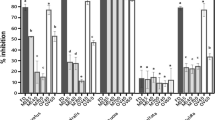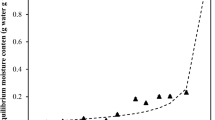Abstract
Drying kinetics, proximate composition, dietary fiber, total phenolic compounds, pigments, amino acid profile, and antioxidant capacity (2,2-diphenyl-1-picrylhydrazyl (DPPH) and oxygen radical absorbance capacity) of a red edible seaweed (Pyropia orbicularis) subjected to vacuum drying at five temperatures (40–80 °C) were evaluated. The experimental drying curves were satisfactorily fitted to the Weibull model. The total dietary fiber (TDF) of this seaweed presented a value of 64.37 g (100 g)−1 d.m. The ratio IDF:TDF was 81.1%. The values for protein ranged between 22.34 and 24.92 g (100 g)−1 d.m. in dried seaweed, and His, Thr, and Pro were the most abundant amino acids. The chlorophyll a content was higher than that for chlorophyll b. Total phenolic content (TPC), phycoerythrin and phycocyanin contents, and carotenoid content as well as antioxidant capacity showed an increase at 70 °C. Moreover, at 70 °C, ΔE presented a value of 15.66. Correlations between the TPC and DPPH values (r 2 = 0.899) as well as lightness and hue angle (r 2 = 0.776) were found during food drying. This work provides important information about the chemical composition and nutraceutical properties of the Chilean edible red seaweed, P. orbicularis.

Similar content being viewed by others
References
Agregán R, Munekata PE, Domínguez R, Carballo J, Franco D, Lorenzo JM (2016) Proximate composition, phenolic content and in vitro antioxidant activity of aqueous extracts of the seaweeds Ascophyllum nodosum, Bifurcaria bifurcata and Fucus vesiculosus. Effect of addition of the extracts on the oxidative stability of canola oil under accelerated storage conditions. Food Res Int. doi:10.1016/j.foodres.2016.11.009
Ahmad-Qasem MH, Barrajon-Catalan E, Micol V, Cárcel JA, García-Pérez JV (2013) Influence of air temperature on drying kinetics and antioxidant potential of olive pomace. J Food Eng 119:516–524
Ait Mohamed L, Kane CSE, Kouhila M, Jamali A, Mahrouz M, Kechaou N (2008) Thin layer modelling of Gelidium sesquipedale solar drying process. Energy Convers Manag 49:940–946
Ait Mohamed L, Kouhila M, Lahsasni S, Jamali A, Idlimam A, Rhazi M, Aghfir M, Mahrouz M (2005) Equilibrium moisture content and heat of sorption of Gelidium sesquipedale. J Stored Prod Res 41:199–209
AOAC (1990) Official method of analysis. Association of official analytical chemists, 15th ed. Washington. DC. USA: Association of Official Analytical Chemists
Astorga-España MS, Mansilla A (2014) Sub-Antarctic macroalgae: opportunities for gastronomic tourism and local fisheries in the Region of Magallanes and Chilean Antarctic Territory. J Appl Phycol 26:973–978
Astorga-España MS, Rodríguez-Galdón B, Rodríguez-Rodríguez EM, Díaz-Romero C (2016) Amino acid content in seaweeds from the Magellan Straits (Chile). J Food Comp Anal 53:77–84
Beer S, Eshel A (1985) Determining phycoerythrin and phycocyanin concentrations in aqueous crude extracts of red algae. Aust J Mar Freshw Res 36:785–792
Brand-Williams W, Cuvelier ME, Berset C (1995) Use of a free radical method to evaluate antioxidant activity. LWT–Food Sci Technol 28:25–30
Brown E, Allsopp P, Magee P, Gill C, Nitecki S, Strain C, McSorley E (2014) Seaweed and human health. Nutr Rev 72:205–216
Chan PT, Matanjun P (2017) Chemical composition and physicochemical properties of tropical red seaweed, Gracilaria changii. Food Chem 221:302–310
Chuah AM, Lee Y-C, Yamaguchi T, Takamura H, Yin L-J, Matoba T (2008) Effect of cooking on the antioxidant properties of coloured peppers. Food Chem 111:20–28
Cian RE, Caballero MS, Sabbag N, González RJ, Drago SR (2014b) Bio-accessibility of bioactive compounds (ACE inhibitors and antioxidants) from extruded maize products added with a red seaweed Porphyra columbina. LWT–Food Sci Technol 55:51–58
Cian RE, Fajardo MA, Alaiz M, Vioque J, González RJ, Drago SR (2014a) Chemical composition, nutritional and antioxidant properties of the red edible seaweed Porphyra columbina. Int J Food Sci Nutr 65:299–305
Cian RE, Garzón AG, Ancona DB, Guerrero LC, Drago SR (2015) Hydrolyzates from Pyropia columbina seaweed have antiplatelet aggregation, antioxidant and ACE I inhibitory peptides which maintain bioactivity after simulated gastrointestinal digestion. LWT–Food Sci Technol 64:881–888
Cian RE, Martínez-Augustin O, Drago SR (2012) Bioactive properties of peptides obtained by enzymatic hydrolysis from protein byproducts of Porphyra columbina. Food Res Int 49:364–372
Contreras-Porcia L, López-Cristoffanini C, Lovazzano C, Flores-Molina MR, Thomas D, Núñez A, Fierro C, Guajardo E, Correa JA, Kube M, Reinhardt R (2013) Differential gene expression in Pyropia columbina (Bangiales, Rhodophyta) under natural hydration and desiccation conditions. Lat Am J Aquat Res 41(5):933–958
Corzo O, Bracho N, Pereira A, Vásquez A (2008) Weibull distribution for modeling air drying of coroba slices. LWT–Food Sci Technol 41:2023–2028
Cox S, Gupta S, Abu-Ghannam N (2011) Application of response surface methodology to study the influence of hydrothermal processing on phytochemical constituents of the Irish edible brown seaweed Himanthalia elongata. Bot Mar 54:471–480
Cox S, Gupta S, Abu-Ghannam N (2012) Effect of different rehydration temperatures on the moisture, content of phenolic compounds, antioxidant capacity and textural properties of edible Irish brown seaweed. LWT–Food Sci Technol 47:300–307
Dawczynski C, Schubert R, Jahreis G (2007) Amino acids, fatty acids, and dietary fibre in edible seaweed products. Food Chem 103:891–899
El-Din SMM, El-Ahwany AMD (2016) Bioactivity and phytochemical constituents of marine red seaweeds (Jania rubens, Corallina mediterranea and Pterocladia capillacea). J Taibah Univ Sci 10:471–484
Elleuch M, Bedigian D, Roiseux O, Besbes S, Blecker C, Attia H (2011) Dietary fibre and fibre rich by-products of food processing: characterisation, technological functionality and commercial applications: a review. Food Chem 124:411–421
Farvin KHS, Jacobsen C (2013) Phenolic compounds and antioxidant activities of selected species of seaweeds from Danish coast. Food Chem 138:1670–1681
Fernández-Rojas B, Medina-Campos O, Hernández-Pando R, Negrette-Guzmán M, Huerta-Yepez S, Pedraza-Chaverri J (2014) C-Phycocyanin prevents cisplatin-induced nephrotoxicity through inhibition of oxidative stress. Food Funct 5:480–490
Ferraces-Casais P, Lage-Yusty MA, Rodríguez-Bernaldo de Quirós A, López-Hernández J (2012) Evaluation of bioactive compounds in fresh edible seaweeds. Food Anal Meth 5:828–834
Gómez-Ordóñez E, Jiménez-Escrig A, Rupérez P (2010) Dietary fibre and physicochemical properties of several edible seaweeds from the northwestern Spanish coast. Food Res Int 43:2289–2294
Gong M, Bassi A (2016) Carotenoids from microalgae: a review of recent developments. Biotechnol Adv 34:1396–1412
Gupta S, Cox S, Abu-Ghannam N (2011) Effect of different drying temperatures on the moisture and phytochemical constituents of edible Irish brown seaweed. LWT–Food Sci Technol 44:1266–1272
Hayashi L, Bulboa C, Kradolfer P, Soriano G, Robledo D (2014) Cultivation of red seaweeds: a Latin American perspective. J Appl Phycol 26:719–727
Hwang E-S, Do Thi N (2014) Effects of extraction and processing methods on antioxidant compound contents and radical scavenging activities of laver (Porphyra tenera). Prev Nutr Food Sci 19:40–48
Jeffrey SW, Humphrey GF (1975) New spectrophotometric equation for determining chlorophyll a, b, c 1 and c 2 in higher plants, algae and natural phytoplankton. Biochem Physiol Pflanz 167:194–204
Kadam S, Tiwari B, O’Donnell C (2015) Effect of ultrasound pre-treatment on the drying kinetics of brown seaweed Ascophyllum nodosum. Ultrason Sonochem 23:302–307
Lajili S, Deghrigue M, Bel Haj Amor H, Muller C, Bouraoui A (2016) In vitro immunomodulatory activity and in vivo anti-inflammatory and analgesic potential with gastroprotective effect of the Mediterranean red alga Laurencia obtusa. Pharm Biol 54:2486–2495
Lemus R, Pérez M, Andrés A, Roco T, Tello C, Vega A (2008) Kinetic study of dehydration and desorption isotherms of red alga Gracilaria. LWT–Food Sci Technol 41:1592–1599
Makkar H, Tran G, Heuzé V, Giger-Reverdin S, Lessiree M, Lebasf F, Ankers P (2016) Seaweeds for livestock diets: a review. Anim Feed Sci Technol 212:1–17
Matanjun P, Mohamed S, Mustapha NM, Muhammad K (2009) Nutrient content of tropical edible seaweeds, Eucheuma cottoni, Caulerpa lentillifera and Sargassum polycystum. J Appl Phycol 21:75–80
Michalska A, Wojdyło A, Lech K, Łysiak G, Figiel A (2016) Physicochemical properties of whole fruit plum powders obtained using different drying technologies. Food Chem 207:223–232
Mohamed S, Hashim SN, Rahman HA (2012) Seaweeds: a sustainable functional food for complementary and alternative therapy. Trends Food Sci Tech 23:83–96
Moreira R, Chenlo F, Sineiro J, Arufe S, Sexto S (2016b) Water sorption isotherms and air drying kinetics of Fucus vesiculosus brown seaweed. J Food Process Preserv. doi:10.1111/jfpp.12997
Moreira R, Chenlo F, Sineiro J, Sánchez M, Arufe S (2016a) Water sorption isotherms and air drying kinetics modeling of the brown seaweed Bifurcaria bifurcata. J Appl Phycol 28:609–618
Munier M, Moranҫais M, Dumay J, Jaouen P, Fleurence J (2015) One-step purification of R-phycoerythrin from the red edible seaweed Grateloupia turuturu. J Chromatogr B 992:23–29
Nakagawa K, Ritcharoen W, Sri-Uam P, Pavasant P, Adachi S (2016) Antioxidant properties of convective-air-dried Spirulina maxima: evaluation of phycocyanin retention by a simple mathematical model of air-drying. Food Bioprod Process 100:292–302
Neoh YY, Matanjun P, Lee JS (2016) Comparative study of drying methods on chemical constituents of Malaysian red seaweed. Dry Technol 34:1745–1751
Nguyen VT, Ueng J-P, Tsai G-J (2011) Proximate composition, total phenolic content, and antioxidant activity of seagrape (Caulerpa lentillifera). J Food Sci 76:C950–C958
Olivares-Molina A, Fernández K (2016) Comparison of different extraction techniques for obtaining extracts from brown seaweeds and their potential effects as angiotensin I-converting enzyme (ACE) inhibitors. J Appl Phycol 28:1295–1302
Ou B, Huang D, Hampsch-Woodill M, Flanagan JA, Deemer EK (2002) Analysis of antioxidant activies of common vegetables employing oxygen radical absorbance capacity (ORAC) and ferric reducing antioxidant power (FRAP) assays: a comparative study. J Agric Food Chem 50:3122–3128
Pérez AA, Farías SS, Strobl AM, Pérez CM, Piñeiro A, Roses O, Fajardo MA (2007) Levels of essential and toxic elements in Porphyra columbina and Ulva sp. from San Jorge Gulf, Patagonia Argentina. Sci Total Environ 376(1–3):51–59
Pina AL, Costa AR, Lage-Yusty MA, López-Hernández J (2014) An evaluation of edible red seaweed (Chondrus crispus) components and their modification during the cooking process. LWT–Food Sci Technol 56:175–180
Rajauria G, Jaiswal AK, Abu-Gannam N, Gupta S (2013) Antimicrobial, antioxidant and free radical-scavenging capacity of brown seaweed Himanthalia elongata from western coast of Ireland. J Food Biochem 37:322–335
Ramírez ME, Contreras-Porcia L, Guillemin M-L, Brodie J, Valdivia C, Flores-Molina MR, Núñez A, Contador CB, Lovazzano C (2014) Pyropia orbicularis sp. nov. (Rhodophyta, Bangiaceae) based on a population previously known as Porphyra columbina from the central coast of Chile. Phytotaxa 158(2):133–153
Roohinejad S, Koubaa M, Barba FJ, Saljoughian S, Amid M, Greiner R (2016) Application of seaweeds to develop new food products with enhanced shelf-life, quality and health-related beneficial properties. Food Res Int http://dx.doi.org/10.1016/j.foodres.2016.08.016
Rupérez P, Saura-Calixto F (2001) Dietary fibre and physicochemical properties of edible Spanish seaweeds. Eur Food Res Technol 212:349–354
Tello-Ireland C, Lemus-Mondaca R, Vega-Gálvez A, López J, Di Scala K (2011) Influence of hot-air temperature on drying kinetics, functional properties, colour, phycobiliproteins, antioxidant capacity, texture and agar yield of alga Gracilaria chilensis. LWT–Food Sci Technol 44:2112–2118
Uribe E, Marin D, Vega-Galvez A, Quispe-Fuentes I, Rodriguez A (2016) Assessment of vacuum-dried peppermint (Mentha piperita L.) as a source of natural antioxidants. Food Chem 190:559–565
Vimala B, Thushara R, Nambisan B, Sreekumar J (2011) Effect of processing on the retention of carotenoids in yellow-fleshed cassava (Manihot esculenta Crantz) roots. Int J Food Sci Technol 46:166–169
Yaich H, Garna H, Bchir B, Besbes S, Paquot M, Richel A, Blecker C, Attia H (2015) Chemical composition and functional properties of dietary fibre extracted by Englyst and Prosky methods from the alga Ulva lactuca collected in Tunisia. Algal Res 9:65–73
Zhang L, Li J, Hogan S, Chung H, Welbaum GE, Zhou K (2010) Inhibitory effect of raspberries on starch digestive enzyme and their antioxidant properties and phenolic composition. Food Chem 119:592–599
Zhao Y, Jiang Y, Zheng B, Zhuang W, Zheng Y, Tian Y (2017) Influence of microwave vacuum drying on glass transition temperature, gelatinization temperature, physical and chemical qualities of lotus seeds. Food Chem 228:167–176
Acknowledgments
The authors gratefully acknowledge the Project FONDECYT 1160597 for providing financial support for the publication of this research.
Author information
Authors and Affiliations
Corresponding author
Ethics declarations
Conflict of interest
The authors declare that they have no conflicts of interest.
Rights and permissions
About this article
Cite this article
Uribe, E., Vega-Gálvez, A., Heredia, V. et al. An edible red seaweed (Pyropia orbicularis): influence of vacuum drying on physicochemical composition, bioactive compounds, antioxidant capacity, and pigments. J Appl Phycol 30, 673–683 (2018). https://doi.org/10.1007/s10811-017-1240-1
Received:
Revised:
Accepted:
Published:
Issue Date:
DOI: https://doi.org/10.1007/s10811-017-1240-1




